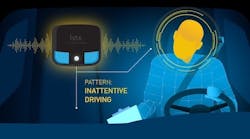By Matthew Ison, Head of Sales for North America, VisionTrack
Construction workers accounted for one in five (21.7 percent) fatal injuries in 2020, yet they made up only 7.3 percent of the U.S. workforce, according to The Center for Construction Research and Training. The use of mobile construction equipment is a significant risk factor.
Although safety protocols minimize the risks involved with heavy equipment, it’s hard to completely eliminate risk altogether. Video telematics, with its ability to provide real-time data for analysis, offers enhanced visibility to support risk detection and prevention, as well as aiding future risk planning.
Filling in the safety blind spot
Even the most experienced equipment operator can find it difficult to detect a sudden, unforeseen, or previously unknown risk and respond quickly and efficiently in the moment. A combination of cameras and sensors give drivers a complete 360-degree view around the machine via an in-cab monitor. Front, side, and rear cameras ensure that equipment is covered from all angles; and corner, side, and rear sensors warn of nearby people—workers, pedestrians, or cyclists—especially in blind spots. This system can also be linked to specific driving maneuvers, so a driver can view the appropriate camera when turning. For example, the left-hand indicator or reverse gear links to the correct camera angle when engaged.
AI adds extra intelligence
Artificial intelligence (AI or machine learning) will set the next generation of video telematics apart as it becomes embedded in camera hardware. The latest intelligent detection cameras adopt deep learning technology to provide real-time insight. This enables the cameras to identify and track vulnerable people, making it possible to trigger an alert to the driver, especially when manual detection is difficult due to blind spots. The technology can even activate an external, audible alarm when someone enters virtual exclusion zones around the machine, thereby supporting the operator by alerting those around the machine of the risk while preventative action is taken.
With traditional proximity sensors, inanimate objects can trigger alerts, so operators may become complacent and take less notice of an alarm because of false positives. The AI-powered detection camera can locate people up to 20 meters away in real-time, establishing the severity of risk dependent on their proximity to the equipment. With such high levels of accuracy and range, it provides the operator with increased reaction time and reduces the possibility of collisions.
Cloud-enabled safety enhancements
Camera technology is no longer a simple driving aid. Forward-facing cameras and mobile digital video recorders (MDVRs) can now be connected to a cloud-based platform. Recorded footage and supporting data of any collision, near miss, or harsh driving event is uploaded and can be viewed almost instantly. This provides equipment or safety managers with virtual eyes on the ground, enhancing visibility and control of equipment on site or out on the road.
Everybody in the telematics industry talks about driver behavior and being able to determine how a piece of equipment is being used or treated. With traditional telematics, a machine may record three harsh breaking events, but without more information this is just general trend information.
Video footage combined with telematics data provides important context to the recorded incident, unlocking new value from the machine data. This allows managers to gain insight into the data in order to take targeted and effective action. If a video shows someone doing something risky that is linked to the event, then a more meaningful intervention can be made to improve safety. It also allows driving styles to be measured and analyzed, so steps can be taken as part of a wider safety strategy and training initiative.
Construction businesses can also monitor compliance using captured video and data. Almost any activity can trigger a recording by combining video telematics with event tracking on the equipment. Because cameras can be fitted almost anywhere on the machine, it is possible to ensure that operators are not ignoring safety procedures and investigate following a complaint or incident.
Take, for example, entering or exiting the cab, which is a leading cause of slips, trips, and falls (STF). A video telematics solution can connect a side camera to the door sensor, so footage is captured to validate that drivers are always facing the equipment and have three points of contact with the machinery. This means driver wellbeing is improved, while a company can reduce absenteeism and protect against potential injury claims.
The Occupational Safety and Health Administration identifies video as one method to detect and remove risk. But video telematics takes risk identification and management one step further by continuously monitoring real-time risk and using this data, with the help of AI, to plot patterns and build up a clear plan for risk mitigation.
Cloud platforms can improve safety compliance with additional safety features such as the occupant safety rating that monitors the wellbeing of the driver and can even alert emergency services to severe distress or injury following a collision.
Telematics alone can only go so far to prevent safety risks, as it offers only a vague image of the level of safety, with out-of-context incidents and potential false alarms. But real-time video and telematics data combined in AI-powered video telematics can make telematics data more actionable.
This data can power the safety feedback loop to continuously improve safety procedures, keeping workers and the public safe and reducing collateral costs.
Source: VisionTrack









